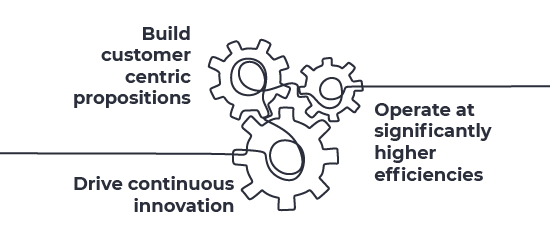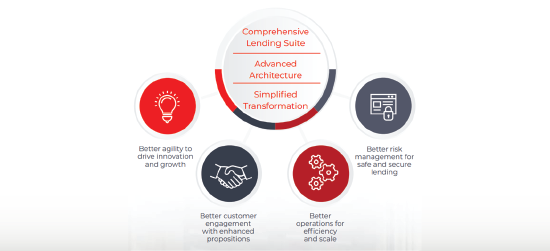The lending industry is being reshaped by a confluence of forces.
Concerned about potential losses due to the wayward economic conditions, traditional lenders are tightening standards. On the other hand, alternative lenders are making further inroads into the business with superior service and experience that consumers, with their preference for digital engagement and zero touch, are welcoming. Meanwhile, the forces of regulation continue to build up worldwide, aiming to safeguard customer rights and prevent loan frauds. The last force is emerging technologies, including Cloud, API (Application Programming Interface), Artificial Intelligence and machine learning, which are enabling new competitors to enter with innovative, low cost, disruptive models to threaten incumbent banks that are still on legacy technology.
Like every industry, lending business was adversely impacted by the Covid-19 pandemic. Businesses faced a severe cash crunch caused by strict lockdowns. Industrial activity came to a standstill and jobs were lost across the board. This had a cascading effect on both consumer and business loans: retail loan delinquency almost doubled, and a similar trend seen in mortgage loans. Consequently, banks’ non-performing assets rose in the subsequent quarters.
As the storm withers away, and the pandemic waves subside, to stay relevant and thrive in the lending business with new momentum, one needs to play their best and win the market share! And for this, we believe it is time for banks to go back to basics or the first principles thinking to reimagine their lending business for the digital age. Broadly, this involves the following below three considerations.

Build customer-centric propositions
A modern digital platform is indispensable to customer-centric lending. The right platform offers customers the convenience of anytime-anyplace access to loan application, approval and disbursement within minutes, configurable products and prices, and hyper-personalized offers that are well integrated into their primary journeys.
Operate at significantly higher efficiencies
Efficiency improvement is one of the key promises of a digital lending platform, which enables banks to go paperless, minimize or even eliminate human intervention, and gain visibility into lending processes. Automation across the front, middle and back office raises efficiency throughout the lending value chain. The unified platform also strengthens the blended workforce proposition where a digital workforce operates alongside humans to amplify lending outcomes, across customer segments.
Drive continuous innovation
A digitally native platform’s biggest advantage is that it elevates innovation ability to new levels. For instance, it enables banks to create lending models that transcend asset-based and other traditional models and also supports customer centric design and customer-designed products. It allows for risks assessment through a host of non-traditional data sets available publicly or through interfacing agencies. Over and above this, it facilitates collaboration with the ecosystem using APIs so the bank can practice marketplace lending, build syndicated lending products and add complementary products like insurance to home loans.
Here is how Bank BRI built a winning customer-centric proposition
At Finacle, we have been the partner of choice for both banks and other FIs across these focus areas to accelerate their journey towards a truly digital lending platform. Finacle brings rich experience in digital lending transformation having delivered more than 450+ lending deployments in over 90 countries.
Today, I will talk about our work with banks across regions in helping them build customer-centric propositions. One such example is PT Bank Rakyat Indonesia Tbk which is one of the largest banks in Indonesia. It specializes in small scale and microfinance style borrowing from and lending to its approximately 30 million retail clients. Bank BRI decided to tap into and leverage the enormous growth potential in the unbanked sector of the country with Ceria, a digital lending app, thus helping the country’s millennials grow their financial assets and build a stable credit history. Bank BRI Ceria provides:

Convenience: The card-less credit app is fully mobile, swift, simplified, enables self-service
Speed: Ceria has the fastest loan approval and disbursement process of 2 minutes (from loan origination to loan disbursement).
Price Competitiveness: Ceria offers the lowest rates for digital lending with a flat interest rate of 1.41 percent per month or 17.04 percent per year, making it a highly compelling proposition.
Integration with primary journeys: BRI’s high-tech low-interest approach through Ceria is influenced by demands brought by shifting millennial consumer behavior and the e-commerce market that is projected to grow to US$82 billion by 2025. Ceria offers fully-digital loans upto $1,500 for e-commerce purchases with buy now and pay later (BNPL) features.
Since its launch in the first quarter of 2019, Ceria has seen its loan portfolio grow by 6x year on year. In 2021, Ceria has onboarded 2,000-2,500 customers and has created 11 billion Rp (US$758,00) credit facilities per day, until the second quarter. Bank BRI is now developing Ceria API to tap into digital ecosystems across the larger ecosystem, to empower customers beyond the bank’s network.
Finacle’s Approach to Driving customer-centricity in lending
Mobile-first strategies and simplified online interfaces are fundamentally changing customer experience and digital engagement in banking, including lending, by improving access, convenience, security and speed. With companies accelerating the digitization of their lending operations, the demand for sophisticated digital lending solutions to drive deeper customer engagement, is on the rise.

Finacle’s approach to helping banks maximize customer engagement for enhanced proposition includes:
However, this is only one element of our promise. We offer an industry-leading solution suite designed to accelerate your journey towards a truly digital lending platform. Click here to know more about our proposition.
